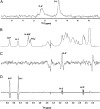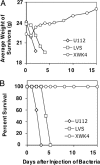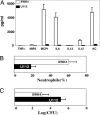Attenuated virulence of a Francisella mutant lacking the lipid A 4'-phosphatase
- PMID: 17360489
- PMCID: PMC1820721
- DOI: 10.1073/pnas.0611606104
Attenuated virulence of a Francisella mutant lacking the lipid A 4'-phosphatase
Abstract
Francisella tularensis causes tularemia, a highly contagious disease of animals and humans, but the virulence features of F. tularensis are poorly defined. F. tularensis and the related mouse pathogen Francisella novicida synthesize unusual lipid A molecules lacking the 4'-monophosphate group typically found in the lipid A of Gram-negative bacteria. LpxF, a selective phosphatase located on the periplasmic surface of the inner membrane, removes the 4'-phosphate moiety in the late stages of F. novicida lipid A assembly. To evaluate the relevance of the 4'-phosphatase to pathogenesis, we constructed a deletion mutant of lpxF and compared its virulence with wild-type F. novicida. Intradermal injection of 10(6) wild-type but not 10(8) mutant F. novicida cells is lethal to mice. The rapid clearance of the lpxF mutant is associated with a stronger local cytokine response and a greater influx of neutrophils compared with wild-type. The F. novicida mutant was highly susceptible to the cationic antimicrobial peptide polymyxin. LpxF therefore represents a kind of virulence factor that confers a distinct lipid A phenotype, preventing Francisella from activating the host innate immune response and preventing the bactericidal actions of cationic peptides. Francisella lpxF mutants may be useful for immunization against tularemia.
Conflict of interest statement
The authors declare no conflict of interest.
Figures





Similar articles
-
Expression cloning and periplasmic orientation of the Francisella novicida lipid A 4'-phosphatase LpxF.J Biol Chem. 2006 Apr 7;281(14):9321-30. doi: 10.1074/jbc.M600435200. Epub 2006 Feb 8. J Biol Chem. 2006. PMID: 16467300 Free PMC article.
-
TolC and EmrA1 contribute to Francisella novicida multidrug resistance and modulation of host cell death.J Bacteriol. 2024 Sep 19;206(9):e0024624. doi: 10.1128/jb.00246-24. Epub 2024 Aug 28. J Bacteriol. 2024. PMID: 39194223 Free PMC article.
-
Role of Francisella lipid A phosphate modification in virulence and long-term protective immune responses.Infect Immun. 2012 Mar;80(3):943-51. doi: 10.1128/IAI.06109-11. Epub 2012 Jan 3. Infect Immun. 2012. PMID: 22215738 Free PMC article.
-
Comparative review of Francisella tularensis and Francisella novicida.Front Cell Infect Microbiol. 2014 Mar 13;4:35. doi: 10.3389/fcimb.2014.00035. eCollection 2014. Front Cell Infect Microbiol. 2014. PMID: 24660164 Free PMC article. Review.
-
Live Attenuated Tularemia Vaccines for Protection Against Respiratory Challenge With Virulent F. tularensis subsp. tularensis.Front Cell Infect Microbiol. 2018 May 15;8:154. doi: 10.3389/fcimb.2018.00154. eCollection 2018. Front Cell Infect Microbiol. 2018. PMID: 29868510 Free PMC article. Review.
Cited by
-
Microbial activities and intestinal homeostasis: A delicate balance between health and disease.Cell Mol Gastroenterol Hepatol. 2015 Jan;1(1):28-40. doi: 10.1016/j.jcmgh.2014.11.004. Cell Mol Gastroenterol Hepatol. 2015. PMID: 25729763 Free PMC article.
-
Repression of bacterial lipoprotein production by Francisella novicida facilitates evasion of innate immune recognition.Cell Microbiol. 2012 Oct;14(10):1531-43. doi: 10.1111/j.1462-5822.2012.01816.x. Epub 2012 Jun 12. Cell Microbiol. 2012. PMID: 22632124 Free PMC article.
-
The lipopolysaccharide from Capnocytophaga canimorsus reveals an unexpected role of the core-oligosaccharide in MD-2 binding.PLoS Pathog. 2012;8(5):e1002667. doi: 10.1371/journal.ppat.1002667. Epub 2012 May 3. PLoS Pathog. 2012. PMID: 22570611 Free PMC article.
-
Purification and characterization of the lipid A 1-phosphatase LpxE of Rhizobium leguminosarum.J Biol Chem. 2009 Jan 2;284(1):414-425. doi: 10.1074/jbc.M808390200. Epub 2008 Nov 4. J Biol Chem. 2009. PMID: 18984595 Free PMC article.
-
Reciprocal analysis of Francisella novicida infections of a Drosophila melanogaster model reveal host-pathogen conflicts mediated by reactive oxygen and imd-regulated innate immune response.PLoS Pathog. 2010 Aug 26;6(8):e1001065. doi: 10.1371/journal.ppat.1001065. PLoS Pathog. 2010. PMID: 20865166 Free PMC article.
References
-
- Raetz CRH. Annu Rev Biochem. 1990;59:129–170. - PubMed
-
- Poltorak A, He X, Smirnova I, Liu MY, Huffel CV, Du X, Birdwell D, Alejos E, Silva M, Galanos C, et al. Science. 1998;282:2085–2088. - PubMed
-
- Hoshino K, Takeuchi O, Kawai T, Sanjo H, Ogawa T, Takeda Y, Takeda K, Akira S. J Immunol. 1999;162:3749–3752. - PubMed
-
- Akira S, Uematsu S, Takeuchi O. Cell. 2006;124:783–801. - PubMed
Publication types
MeSH terms
Substances
Grants and funding
LinkOut - more resources
Full Text Sources
Other Literature Sources

